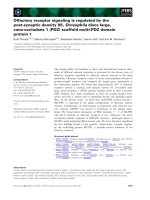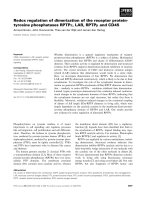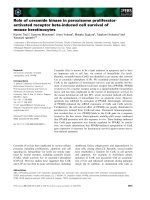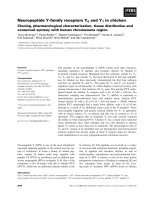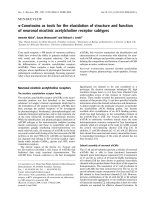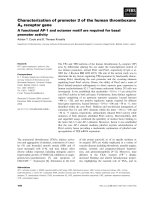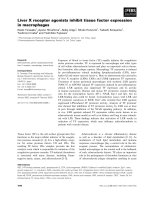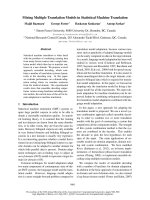Báo cáo khoa học: Liver receptor homolog-1 localization in the nuclear body is regulated by sumoylation and cAMP signaling in rat granulosa cells docx
Bạn đang xem bản rút gọn của tài liệu. Xem và tải ngay bản đầy đủ của tài liệu tại đây (706.9 KB, 12 trang )
Liver receptor homolog-1 localization in the nuclear body
is regulated by sumoylation and cAMP signaling in rat
granulosa cells
Feng-Ming Yang, Chien-Ting Pan, Huei-Man Tsai, Tai-Wei Chiu, Mei-Ling Wu and Meng-Chun Hu
Graduate Institute of Physiology, National Taiwan University College of Medicine, Taipei, Taiwan
Liver receptor homolog-1 (LRH-1; NR5A2), a member
of the nuclear hormone receptor NR5A subfamily, was
originally identified to be the mammalian homolog
of the Drosophila fushi tarazu factor 1 (Ftz-F1). LRH-1
is mainly expressed in tissues derived from the gut
endoderm, including the liver, pancreas and intestine,
and high levels of LRH-1 are also found in the
ovary [1,2]. LRH-1 knockout mice die at embryonic
day 7.5, indicating that LRH-1 plays a crucial role
in development [3]. In enterohepatic tissues, LRH-1 is
involved in cholesterol and bile acid homeostasis
by regulating several essential genes in the reverse
cholesterol transport and bile acid synthesis pathways
[4–7].
Keywords
cAMP signaling; CYP11A1; granulosa cells;
liver receptor homolog-1; sumoylation
Correspondence
M C. Hu, Graduate Institute of Physiology,
National Taiwan University College of
Medicine, No. 1, Jen-Ai Road, 1st Section,
Taipei 100, Taiwan
Fax: +886 2 23964350
Tel: +886 2 23123456 ext. 88239
E-mail:
(Received 7 July 2008, revised 3 November
2008, accepted 10 November 2008)
doi:10.1111/j.1742-4658.2008.06785.x
Liver receptor homolog-1 (LRH-1; NR5A2) is an orphan member of the
nuclear receptor superfamily, mainly expressed in endoderm-derived tissues
and in the ovary. In ovarian granulosa and luteal cells, LRH-1 regulates the
expression of genes associated with ovarian steroidogenesis. LRH-1 can be
transported to transcriptionally inactive nuclear bodies after conjugation
with small ubiquitin-related modifier (SUMO). In the present study, we
investigated the effects of SUMO modification at five lysine residues of
LRH-1 in rat granulosa cells. Lysine 289 could be conjugated with SUMO-
1 in vitro, and the mutation K289R increased transcriptional activity
of LRH-1, suggesting that SUMO conjugation is associated with transcrip-
tion repression. Coexpression of SUMO-1 targets LRH-1 to the dot-like
nuclear bodies, but the effect of lysine mutations on blocking subnuclear
localization depended on the cell type. In COS-7 cells, mutation of either
K173 or K289 prevented SUMO-1-mediated translocation of LRH-1 into
nuclear bodies and also reduced the conjugation by SUMO-1, suggesting
that K289 and K173 are two important sites involved in SUMO-1 modifica-
tion. In granulosa cells, three or more altered lysine residues were required
for nucleoplasm retention. This result suggests that multiple lysine residues
are targets for SUMO conjugation in vivo and granulosa cells are more sen-
sitive to SUMO-1-mediated LRH-1 localization to nuclear bodies. Nuclear
body localization of LRH-1 was suppressed by forskolin and cholera toxin.
Forskolin treatment obviously influences the expression of members
involved in the SUMO pathway. The results obtained in the present study
suggest that cAMP signaling could change the dynamic process of sumoyla-
tion and repress LRH-1 targeting to nuclear speckles in rat granulosa cells.
Abbreviations
CYP11A1, cholesterol side-chain cleavage cytochrome P450; Ftz-F1, Drosophila fushi tarazu factor 1; GFP, green fluorescence protein;
HESC, human endometrial stromal cells; LRH-1, liver receptor homolog-1; PIAS, protein inhibitor of activated STAT; PMA, 4b-phorbol
12-myristate 13-acetate; SENP, SUMO-specific protease; SF-1, steroidogenic factor-1; SUMO, small ubiquitin-related modifier.
FEBS Journal 276 (2009) 425–436 ª 2008 The Authors Journal compilation ª 2008 FEBS 425
In the ovary, LRH-1 is abundantly expressed in
granulosa and luteal cells [8,9]. LRH-1 stimulates the
promoter activity of several steroidogenic genes
[10,11] in ovarian granulosa cells, demonstrating that
LRH-1 is a potent regulator of ovarian steroidogene-
sis. Mice with granulosa-specific knockout of the
LRH-1 are sterile and exhibit deficiencies in ovula-
tion, progesterone production and corpus luteum
formation [12]. This indicates that LRH-1 is essential
for female reproductive function. In addition, LRH-1
enhances aromatase promoter II expression in breast
adipose and may play a role in breast tumor develop-
ment [13,14].
Nuclear hormone receptors are typically ligand-acti-
vated transcription factors and their activities are
modulated by coactivators and corepressors [15]. The
physiological agonists for LRH-1 have yet to be
defined. Several coregulators such as multiprotein
bridging factor 1 [16], short heterodimer partner [6]
and the dosage-sensitive sex reversal-adrenal hypopla-
sia congenital critical region on the X chromosome,
gene-1 [11,17] have been reported to interact with
LRH-1 and to affect LRH-1-mediated gene activation.
In addition, the activity of LRH-1 is modulated by
post-translational modification. The transcriptional
activity of LRH-1 is stimulated by phosphorylation
following 4b-phorbol 12-myristate 13-acetate (PMA)
induction [18], and serine residues 238 and 243 in the
hinge region of human LRH-1 are important in this
PMA-dependent transactivation.
Recently, sumoylation was reported to comprise
another important post-translational regulatory mecha-
nism. The small ubiquitin-related modifier (SUMO) is
covalently linked to lysines in target proteins through
sequential enzymatic reactions that are similar to ubiq-
uitination and require an E1-activation enzyme (i.e. a
heterodimer of SAE1 and SAE2) and the E2-conjugat-
ing enzyme UBC9 [19]. Several E3 ligases, such as
protein inhibitor of activated STAT (PIAS) family
proteins, have been described to promote the transfer
of SUMO from E2 to target proteins in vivo. The
attachment of SUMO may result in diverse effects on
the substrate protein, including cellular and subnuclear
localization [20,21], changes in stability [22] and tran-
scriptional activity [23,24]. SUMO conjugation is
dynamic and reversible. SUMO-specific proteases
(SENPs) remove SUMO conjugates from substrates
[25], and several SENPs have been identified in mam-
mals [25–27]. These SENP enzymes have distinct
subcellular localizations and a substrate preference
[27–30]. SENP1 and SENP2 can deconjugate all
SUMO substrates, and modulate the function of
several transcription factors [31].
LRH-1 is a target protein of SUMO modification
[32,33]. The hinge region lysine, residue 289 in the
mouse and 224 in the human LRH-1, was the major
SUMO conjugation site. Sumoylation of LRH-1 is
associated with the repression of transcriptional activ-
ity and localization in promyelocytic leukemia protein
nuclear bodies [32]. Desumoylation results in the
release of LRH-1 from transcriptionally inert promyel-
ocytic leukemia protein nuclear bodies and access to
active chromatin domains.
As with most SUMO target proteins, the regulation
of LRH-1 sumoylation is not understood. In the pres-
ent study, we examined five potential target lysines for
SUMO modification and identified additional sites that
could be sumoylated in vivo. Mutation of either lysine
173 (K173R) or 289 (K289R) indicated that lysine 173
and 289 were crucial for the transactivation of LRH-1
and SUMO-1-mediated localization to subnuclear
speckles. Furthermore, we demonstrated that no single
lysine residue was absolutely required to target LRH-1
to nuclear bodies in rat granulosa cells that expressed
endogenous LRH-1. Forskolin and cholera toxin
reduced the accumulation of LRH-1 in nuclear bodies.
Forskolin also affected the expression of several
sumoylation enzymes. These results suggest that cAMP
could be an important signaling for regulating the
dynamics of the sumoylation pathway and LRH-1
activity in granulosa cells.
Results
LRH-1 is modified by SUMO-1 in vitro
To examine whether LRH-1 can be modified with
SUMO,
35
S-labeled LRH-1 was synthesized in vitro
and incubated with recombinant SUMO-1 protein, E1
(SAE1 ⁄ SAE2) and E2 (UBC9) enzymes. Upon separa-
tion of the reaction products by SDS ⁄ PAGE, a slower-
migrating band at approximately 110 kDa was
observed in addition to the major LRH-1 band
(Fig. 1A, lane 2), which was not present in the absence
of SUMO-1, E1 or E2 (Fig. 1A, lanes 3–5), suggesting
that the slow-migrating band represented the SUMO-
conjugated form of LRH-1. SUMO is known to be
covalently attached to a lysine residue with a consen-
sus sequence WKX(E ⁄ D), in which W represents a
large hydrophobic residue [34]. We found five lysine
residues in the WKX(E ⁄ D) consensus sequence at
amino acids 173, 213, 289, 329 and 389. To determine
the lysine residues of LRH-1 responsible for SUMO
attachment, we mutated these five potential target
lysines to arginine (K173R, K213R, K289R, K329R
and K389R) and analyzed the effect of these mutations
LRH-1 subnuclear localization in granulosa cells F M. Yang et al.
426 FEBS Journal 276 (2009) 425–436 ª 2008 The Authors Journal compilation ª 2008 FEBS
on in vitro sumoylation. As shown in Fig. 1B, the
SUMO-1-modified products were generated from
K173R, K213R, K329R and K389R mutants, as well
as from wild-type LRH-1. By contrast, the sumoylated
form of LRH-1 was not found in the K289R mutant,
suggesting that lysine 289 could be the major site for
SUMO-1 conjugation in vitro.
Sumoylation site lysine 289 negatively regulates
LRH-1-mediated transcription
To evaluate the effect of sumoylation on LRH-1 tran-
scriptional activity, wild-type or lysine mutants of
LRH-1 were transfected into COS-7 cells with choles-
terol side-chain cleavage cytochrome P450 (CYP11A1)
promoter-linked luciferase. As shown in Fig. 2, LRH-1
strongly enhanced the activity of the 4.4 kb CYP11A1
promoter in COS-7 cells. The sumoylation-deficient
mutant K289R had two-fold higher transcriptional
activity compared to wild-type LRH-1, whereas
mutants K173R, K213R, K329R and K389R had simi-
lar activity to the wild-type (Fig. 2). This result is
consistent with the earlier notion that sumoylation
mutants have higher transcriptional activities [32,33].
These results suggest that the region around the
SUMO conjugation site functions as a repression
domain, which may influence the transcriptional activ-
ity of LRH-1 via sumoylation.
Lysine 173 and 289 are required for SUMO-1-
mediated localization in nuclear bodies in COS-7
SUMO modification regulates the subcellular localiza-
tion of many target proteins [35]. We thus examined
whether SUMO modification affects the localization of
LRH-1. COS-7 cells were cotransfected with expression
plasmids encoding LRH-1 fused to enhanced green flu-
orescence protein (GFP-LRH1) and DsRed-tagged
SUMO-1. In cells transfected with GFP-LRH1 alone,
GFP-LRH1 was diffusely distributed throughout the
nucleus (data not shown). However, in the presence of
SUMO-1, wild-type LRH-1 was strongly colocalized
with SUMO-1 in the dot-like nuclear bodies
(Fig. 3A,a). To determine whether SUMO-1 conjuga-
tion is required for LRH-1 localization to nuclear
bodies, GFP-tagged LRH-1 was cotransfected with
the conjugation-deficient SUMO-1 mutant, DsRed-
SUMO-1 AA [36] into COS-7 cells. As shown in
Fig. 3A,g, both LRH-1 and SUMO-1 AA failed to tar-
get the nuclear bodies, confirming that sumoylation is
required for specific subnuclear localization of LRH-1.
Subsequently, we set out to determine which particu-
lar lysine sumoylation site of LRH-1 is involved in the
SUMO-1-mediated subnuclear localization. Cotransfec-
tion analysis revealed that the localization pattern of
mutants K213R, K329R and K389R was similar to
the wild-type with distinct nuclear bodies (Fig. 3A,
118
85
47
118
85
47
Sumoylation
AB
Fig. 1. LRH-1 conjugates with SUMO-1
in vitro. (A)
35
S-labeled LRH-1 was in vitro
synthesized and subjected to in vitro sumoy-
lation reactions. Proteins SUMO-1, E1 and
UBC9 are required for the in vitro sumoy-
lation of LRH-1. (B) Showing in vitro sumoy-
lation reactions of in vitro translated,
35
S-labeled wild-type LRH-1 and five lysine
substitution mutants. The reaction products
were separated on 10% SDS ⁄ PAGE and
detected by autoradiography.
LRH-1 –
Wt K173R K213R K289R K329R K389R
Relative activity
**
0
0.5
1
1.5
2
2.5
Fig. 2. Mutation at lysine 289 enhances LRH-1 transactivation. The
CYP11A1 promoter-luciferase construct was cotransfected in COS-7
cells with an empty expression vector (–) or expression vectors
for wild-type (Wt) or mutated LRH-1 at lysine site as indicated.
Cells were lysed and assayed for luciferase activity after trans-
fection for 24 h. The relative luciferase activity of each cotrans-
fectant was compared to wild-type construct (arbitrarily set to 1).
Data are expressed as the mean ± SE of three independent
experiments. Mutation at lysine 289 of LRH-1 significantly
enhanced the transactivation (**P < 0.01).
F M. Yang et al. LRH-1 subnuclear localization in granulosa cells
FEBS Journal 276 (2009) 425–436 ª 2008 The Authors Journal compilation ª 2008 FEBS 427
A
BC
a
b
c
d
e
f
g
h
i
j
k
l
Fig. 3. Lysines 173 and 289 are essential for SUMO-1-mediated LRH-1 subnuclear localization in COS-7 cells. (A) EGFP-LRH1 wild-type or
lysine mutants were cotransfected with DsRed-SUMO-1 (a–f) or conjugation-deficient SUMO-1 mutant DsRed-SUMO-1 AA (g–l) into COS-7
cells. After 24 h, cells were fixed and detected by direct fluorescence. Merged images demonstrating co-localization of proteins (yellow) are
shown on the right. Scale bar = 25 lm. (B) COS-7 cells were cotransfected with the CYP11A1 promoter-luciferase reporter plasmid and an
empty expression vector (–) or expression vectors for wild-type (Wt) or mutated FLAG-LRH-1 at lysine site. Cells were lysed and assayed for
luciferase activity after transfection for 24 h. Relative activity is presented as the ratio of luciferase activity of the wild-type construct. Data
are expressed as the mean ± SE values of three independent experiments (**P < 0.01). (C) Wild-type or mutated Myc-LRH-1 was cotrans-
fected with DsRed-SUMO-1 and FLAG-PIAS3 in COS-7 cells. The nuclear extracts were analyzed by immunoblotting with anti-Myc.
LRH-1 subnuclear localization in granulosa cells F M. Yang et al.
428 FEBS Journal 276 (2009) 425–436 ª 2008 The Authors Journal compilation ª 2008 FEBS
c,e,f), whereas sumoylation-defective mutant K289R
was dispersed across the nucleoplasm of COS-7 cells
(Fig. 3A,d). Interestingly, mutant K173R also dis-
played the same diffuse nuclear distribution as mutant
K289R (Fig. 3A,b). The result implicates lysine 173 as
a potential sumoylation site in COS-7 cells. Arginine
substitution at either lysine residue 173 or 289 resulted
in the loss of subnuclear localization, demonstrating
that both lysine residues were necessary for complete
recruitment of LRH-1 to SUMO-1 formed nuclear
bodies in COS-7 cells. Although mutation of lysine 173
had little effect on the LRH-1-mediated transcription
(Fig. 2), the double mutant K173 ⁄ 289R had a further
enhanced activity compared to the K289R mutant
(Fig. 3B). To demonstrate that LRH-1 was modified
by SUMO in cells, COS-7 cells were cotransfected with
Myc-tagged LRH-1 and SUMO-1 in the presence or
absence of an E3 ligase PIAS3. A fraction of slower-
migrating bands could be detected by immunoblotting
with an anti-Myc in the presence of PIAS3 (Fig. 3C,
lane 3), indicating that PIAS3 promotes LRH-1 su-
moylation in cells. Mutation at lysine 289 dramatically
resulted in the loss of SUMO-modified forms (Fig. 3C,
lane 5). The reduction of SUMO-conjugated LRH-1
was also found in mutant K173R, but not in the
K389R mutant (Fig. 3C, lane 4 and 6). Mutation of
both lysine 173 and 289 appeared to abolish sumoyla-
tion completely (Fig. 3C, lane 7). Collectively, these
results demonstrate that lysine 173 and 289 are
involved in the SUMO-1 modification in cells and that
lysine 289 is the major target for SUMO-1 conju-
gation.
Multiple SUMO conjugation is associated with
the targeting of LRH-1 into nuclear bodies that
is inhibited by cAMP signaling
Because the ovary expresses LRH-1, we further exam-
ined the effect of sumoylation site mutation on the
nuclear localization of LRH-1 in primary rat granulosa
cells. By contrast to the results obtained with COS-7
cells, the mutant K289R that could not be sumoylated
in vitro still showed significant subnuclear distribution
patterns when expressed together with SUMO-1 in rat
granulosa cells (Fig. 4D). In addition, mutation at
lysine residues 173, 213, 329 and 389 did not disrupt
the localization of LRH-1 into nuclear bodies with
SUMO-1 (Fig. 4B,C,E,F). Moreover, cotransfection
with DsRed-SUMO-1 AA led to a loss of subnuclear
localization in both wild-type and mutants (Fig. 4G–
L), indicating that SUMO conjugation is necessary for
LRH-1 localization to the nuclear bodies in rat granu-
losa cells. Therefore, none of these five lysine residues
alone was essential for SUMO-1-mediated localization
of LRH-1 to nuclear bodies in rat granulosa cells. To
test whether multiple lysine residues could efficiently
serve as the acceptor sites for SUMO-1 conjugation,
we introduced mutations at lysine residues 173, 213,
329 or 389 into the mutant K289R, respectively, to
generate four double mutants. When cotransfected
with SUMO-1 into granulosa cells, all of the double
mutants yielded a similar speckled nuclear distribution
pattern as the wild-type (Fig. 5A–C; data for mutants
K213 ⁄ 289R and K289 ⁄ 329R not shown). However,
triple-mutations with three arginine substitutions at
173, 213 and 289 or 289, 329 and 389 resulted in some
LRH-1 localization in the nucleoplasm and a reduced
concentration in nuclear bodies (Fig. 5D,E). Further-
more, the five lysine mutant (GFP-LRH1-5KR) was
even more diffusely distributed throughout the nucleus
(Fig. 5F). Taken together, these data suggest that mul-
tiple lysine residues in LRH-1 could be targets for
SUMO-1 conjugation in rat granulosa cells. Mutation
of three or more sites abolished the accumulation of
LRH-1 in nuclear bodies.
It is well known that the control of ovarian function
and steroid production by gonadotrophins is mainly
through the activation of the cAMP ⁄ protein kinase A
pathway. LRH-1 is an important regulator of ovarian
steroidogenesis. The release of LRH-1 from nuclear
bodies increases its transcriptional activity [32]. There-
fore, we tested whether cAMP signaling could affect
the subnuclear localization of LRH-1 in granulosa
cells. The primary rat granulosa cells cotransfected
with LRH-1 and SUMO-1 were treated with forskolin
to increase cAMP levels. As shown in Fig. 6A, LRH-1
is present in the nuclear speckles when SUMO-1 was
present. Forskolin treatment reduced the targeting of
LRH-1 to the nuclear bodies and redistributed LRH-1
to the nucleoplasm (Fig. 6B). A similar result was also
observed when cells were treated with cholera toxin,
an activator of cAMP synthesis (Fig. 6C). However,
addition of the protein kinase C activator PMA to
granulosa cells had little effect on the localization of
LRH-1 into nuclear bodies (Fig. 6D). These results
suggest that cAMP signaling could prevent LRH-1
localization to nuclear bodies of rat granulosa cells.
cAMP signaling pathway regulates the
expression of sumoylation-related enzymes
Because LRH-1 localization in the nuclear speckles is
associated with sumoylation, we therefore determine
whether cAMP signaling affects the SUMO modifica-
tion pathway. We used RT-PCR to study the effects of
forskolin on the expression of genes. We first analyzed
F M. Yang et al. LRH-1 subnuclear localization in granulosa cells
FEBS Journal 276 (2009) 425–436 ª 2008 The Authors Journal compilation ª 2008 FEBS 429
the expression of LRH-1 target gene CYP11A1,a
cAMP-responsive steroidogenic gene, to confirm the
function of forskolin in rat granulosa cells. Forskolin
strongly stimulated CYP11A1 expression in a time-
dependent manner (Fig. 7A). The mRNA levels of
Cpy11a1 were 14-, 50- and 263-fold higher after 3, 12
and 24 h, respectively.
To determine the effect of cAMP on sumoylation
pathway, the expression of the genes for SUMO E1
subunit SAE1 and E2 UBC9 was examined. As shown
in Fig. 7B, SAE1 mRNA levels increased to approxi-
mately 500% of control, whereas UBC9 mRNA levels
decreased by four-fold after forskolin treatment
(Fig. 7C). In addition, forskolin caused a marked
reduction in the mRNA levels of two SUMO E3 ligases:
PIAS3 (by approximately 90%) and PIASxb (by 50%)
(Fig. 7D,F). By contrast, compared to control cells, the
mRNA level of PIASxa was almost completely unaf-
fected by forskolin treatment (Fig. 7E). To further
examine the expression of SUMO-specific protease,
which is capable of reversing sumoylation, we observed
that forskolin resulted in a two-fold increase of SENP2
mRNA levels (Fig. 7G). Down regulation of UBC9 and
PIAS3 proteins was further confirmed by western blot
analysis (Fig. 7H). Taken together, these data show
that cAMP signaling induced a significant change in
expression of several sumoylation-related genes.
Discussion
SUMO modification has recently been recognized as
an important post-translational mechanism regulating
SUMO-1AA MergedLRH-1
GFP-LRH1-
K213R
GFP-LRH1-
K173R
GFP-LRH1
GFP-LRH1-
K289R
GFP-LRH1-
K329R
GFP-LRH1-
K389R
G
H
I
J
K
L
SUMO-1 MergedLRH-1
A
B
C
D
E
F
Fig. 4. No single lysine is essential for SUMO-1-mediated LRH-1 subnuclear localization in rat granulosa cells. EGFP-LRH1 wild-type or lysine
mutants were cotransfected with DsRed-SUMO-1 (A–F) or conjugation-deficient SUMO-1 mutant DsRed-SUMO-1 AA (G–L) into primary rat
granulosa cells. After 24 h, cells were fixed and detected by direct fluorescence. Merged images demonstrating the co-localization of
proteins (yellow) are shown on the right. Scale bar = 25 lm.
LRH-1 subnuclear localization in granulosa cells F M. Yang et al.
430 FEBS Journal 276 (2009) 425–436 ª 2008 The Authors Journal compilation ª 2008 FEBS
the activity and subcellular localization of transcrip-
tional factors [37]. In the present study, we mutated
five lysine residues in consensus SUMO sites and dem-
onstrated that lysine 289 was most efficiently conju-
gated by SUMO-1 in vitro. Similar results were also
observed with steroidogenic factor-1 (SF-1; NR5A1),
the closest mammalian homolog of LRH-1, where
mutation at the major sumoylation site lysine 194 aug-
ments SF-1 activity [36,38].
SUMO modification enables the regulation of sub-
cellular localization of various proteins, such as
HIPK2 and SF-1 [36,39]. In the present study, we
demonstrated that SUMO conjugation is required for
the subnuclear localization of LRH-1. We showed
that, in COS-7 cells, both lysine 173 and 289 were
essential for the localization of LRH-1 to nuclear
bodies and associated with the repression in transcrip-
tional activity, whereas, in rat granulosa cells, triple
mutation of the sumoylation sites was required to pre-
vent LRH-1 localization to nuclear bodies. Differences
in the presence of cellular factors could account for
the cell type-specific effects observed in present study.
Some other factors may also enhance SUMO modifica-
tion of LRH-1 in vivo, such as E3 proteins, or promote
the targeting of sumoylated LRH-1 into nuclear
bodies. The expression of these putative factors could
differ between cells. Whether coordinated SUMO
modifications of these sites are required for the correct
regulation of LRH-1 function in granulosa cells
remains to be determined. Taken together, in addition
to lysine 289, LRH-1 possesses several potential
sumoylation target sites that have not been described
previously. The differential effects of sumoylation of
target sites between COS-7 and granulosa cells suggest
that the in vivo regulation of SUMO conjugation is
likely to be complex.
SUMO-1LRH-1
GFP-LRH1-
K289/389R
GFP-LRH1-
K173/289R
GFP-LRH1-
5KR
GFP-LRH1
GFP-LRH1-
K173/213/289R
GFP-LRH1-
K289/329/389R
A
B
C
D
E
F
Fig. 5. Multiple sites are involved in the SUMO-1-mediated LRH-1
subnuclear localization in rat granulosa cells. EGFP-LRH1 wild-type
(A) or multiple lysine mutants (B–F) were cotransfected with
DsRed-SUMO-1 into primary rat granulosa cells. After 24 h, cells
were fixed and detected by direct fluorescence. 5KR, five muta-
tions at lysine residues 173, 213, 289, 329 and 389. Scale
bar = 25 lm.
SUMO-1LRH-1
CTX
Forskolin
Vehicle
A
C
B
PMA
D
Fig. 6. The cAMP pathway attenuates SUMO-1-mediated LRH-1
subnuclear localization in rat granulosa cells. EGFP-LRH1 wild-type
was cotransfected with DsRed-SUMO-1 into primary rat granulosa
cells. After 24 h, cells were treated with dimethylsulfoxide (vehicle
control), forskolin, cholera toxin (CTX) or PMA for 24 h, before
fixing for fluorescence microscopy. Scale bar = 25 lm.
F M. Yang et al. LRH-1 subnuclear localization in granulosa cells
FEBS Journal 276 (2009) 425–436 ª 2008 The Authors Journal compilation ª 2008 FEBS 431
We found that SUMO-1-mediated accumulation of
LRH-1 in nuclear bodies was suppressed by forskolin
treatment, suggesting that activation of the cAMP
pathway may have a positive regulatory effect on
LRH-1 activity. In response to pituitary gonadotro-
pins, the cAMP signaling pathway is the most impor-
tant pathway in the stimulation of gonadal
steroidogenesis [40]. In addition, LRH-1 is a potent
trans-activator for ovarian steroidogenesis [9,11,41]. It
therefore implicated that cAMP signaling could indi-
rectly modulate LRH-1 activity by keeping LRH-1
away from transcriptionally inert subnuclear locations
to stimulate the expression of steroidogenic genes.
The modification of proteins by SUMO is a highly
dynamic process, and the balance between SUMO
conjugation and deconjugation can be shifted after
exposure of cells to different stimuli. For example,
SUMO conjugation is increased in response to heat
shock or oxidative stress [42,43]. By contrast, a low
concentration of hydrogen peroxide induces protein
desumoylation by inhibition of conjugating enzymes
activity through the formation of a disulfide bridge in
E1 and E2 [44]. In the present study, we observed that
activation of the cAMP pathway caused a significant
change in the sumoylation machinery. The mRNA lev-
els of the E1 activating subunit SAE1 and the SUMO
specific protease SENP2 were increased, whereas
expression of E2 UBC9 and E3 ligases PIAS3 and
PIASxb were reduced upon treatment with forskolin in
rat granulosa cells for 24 h. The changes of SUMO
pathway enzymes by cAMP were also described in
human endometrial stromal cell (HESC) differentiation
[45]. The most significant changes were observed in the
expression of E3-SUMO ligases and SENPs during
HESC differentiation. However, the altered patterns of
these enzymes in HESCs are not completely consistent
with our data. For example, the level of PIAS3 is
increased in HESCs, whereas it is decreased in granu-
losa cells. In addition, cAMP has little effect on the
expression levels of E1, E2 UBC9 and SUMO-1 in
HESCs. However, our data show that the expression
of both E1 and E2 is regulated by cAMP signaling in
granulosa cells and Shao et al. [46] demonstrated that
SUMO-1 expression is decreased after gonadotropin
0
200
400
600
800
SAE1
0
10 000
20 000
30 000
Cyp11a1
0
25
50
75
100
UBC9
0
50
100
PIAS3
0
50
100
PIASx
β
0
100
200
300
SENP2
EA
B
C
D
**
**
**
**
**
**
**
**
**
**
**
**
**
**
**
**
**
% of control
% of control
% of control
% of control% of control
% of control
F
G
% of control
H
C 3 h 12 h 24 h
PIAS3
Actin
Actin
UBC9
a
b
**
0
50
100
150
PIASx
α
C 3 h 12 h 24 hC 3 h 12 h 24 h
C 3 h 12 h 24 h C 3 h 12 h 24 h
C 3 h 12 h 24 h
C 3 h 12 h 24 h
C 3 h 12 h 24 h
Fig. 7. The cAMP pathway regulates the
expression of SUMO pathway genes.
Primary rat granulosa cells were treated
with dimethylsulfoxide (vehicle control, C)
for 24 h or forskolin for 3, 12 or 24 h. (A–G)
RNA was extracted and then quantified by
real-time RT-PCR. Data are expressed as
the mean ± SE relative to control of three
separate experiments. **P < 0.01 com-
pared to control. (H) Protein levels of UBC9
and PIAS3 were analyzed by western
blotting.
LRH-1 subnuclear localization in granulosa cells F M. Yang et al.
432 FEBS Journal 276 (2009) 425–436 ª 2008 The Authors Journal compilation ª 2008 FEBS
treatment in mouse granulosa cells in vivo. These
results suggest that the effect of cAMP signaling on
SUMO pathway is complex and cell type dependent.
Notwithstanding, the up regulation of E1, the down
regulation of E2 or E3 and the increased expression of
SENP2 lead to attenuated SUMO conjugation. In addi-
tion, SUMO-1 expression is reduced upon cAMP acti-
vation in mouse granulosa cells [46]. Therefore,
whether cAMP signaling results in a global hyposu-
moylation of most substrates, including LRH-1,
requires further investigation. However, this may
explain why forskolin could abolish the localization of
LRH-1 to nuclear bodies in granulosa cells. Attenuated
sumoylation in response to cAMP has been identified
in HESCs [45]. A dramatic reduction in the mRNA lev-
els of PIAS3 was noted in the present study. Our data
also show that PIAS3 promotes LRH-1 sumoylation in
COS-7 cells. This suggests that PIAS3 may serve as an
E3 ligase and be involved in the regulation of LRH-1
sumoylation. cAMP is a key signaling pathway for the
stimulation of CYP11A1 expression in steroidogenic
tissues [47]. Multiple and divergent downstream signal-
ing cascades are activated by cAMP in immature and
mature granulosa cells [40]. The altered expression of
SUMO conjugating enzymes by cAMP indicates that
the SUMO pathway could be one of the mechanisms
by which cAMP regulates CYP11A1 expression.
In summary, our data show that LRH-1 may con-
tain multiple sumoylation targets and that sumoylation
regulates the transcriptional activity and subnuclear
localization of LRH-1. In rat granulosa cells, SUMO-
1-mediated subnuclear localization is attenuated by the
cAMP signaling pathway. Our studies further indicate
a novel regulatory mechanism of cAMP signaling for
altering the sumoylation cycle, involving modulating
the expression of sumoylation pathway-related genes
in rat granulosa cells.
Experimental procedures
Cell isolation and culture
All procedures were approved by the National Taiwan
University College of Medicine and College of Public
Health Institutional Animal Care and Use Committee.
Primary granulosa cells were isolated from Wistar rats
purchased from the Laboratory Animal Center, National
Taiwan University College of Medicine (Taipei, Taiwan).
Immature female rats (21–24 days) were injected subcutane-
ously with 15 IU of equine chorionic gonadotrophin
(Sigma, St Louis, MO, USA). After 48 h, ovaries were
excised and placed in DMEM ⁄ F12 medium (Gibco BRL,
Gaithersburg, MD, USA) containing 20 mm Hepes and
antibiotics. Granulosa cells were released by puncturing the
large- and medium-sized follicles with a 25-gauge needle.
Granulosa cells were washed and harvested by brief
centrifugation and then cultured in DMEM ⁄ F12 medium
supplemented with 10% fetal bovine serum and antibiotics.
COS-7 cells were maintained in DMEM ⁄ high glucose (3%),
supplemented with 10% fetal bovine serum.
Plasmid constructs
Plasmid pCMX-mLRH-1 was generously provided by
D. J. Mangelsdorf (Howard Hughes Medical Institute, Uni-
versity of California, Los Angeles, CA, USA) [6]. The full
coding sequence of LRH-1 was digested with EcoRI and
BamHI from pCMX-mLRH-1 and then subcloned into the
pFlag-CMV2 (Sigma), pEGFP-C1 (Clontech, Palo Alto,
CA, USA) and pGEM-7ZF (Promega, Madison, WI, USA)
vectors. Arginine-substitution LRH-1 mutants (K173R,
K213R, K289R, K329R and K389R) were generated based
on pFLAG-LRH1 or pGEM-LRH1 by PCR-based site-
directed mutagenesis [48] and then subcloned into different
vectors. The single mutants LRH-1 K329R and K389R
were then used for the template to create double mutations
K289 ⁄ 329R and K289 ⁄ 389R, respectively, by site-directed
mutagenesis. All mutations were verified by DNA sequenc-
ing. LRH-1 double mutations K173 ⁄ 289R and K213 ⁄ 289R
were obtained by subcloning the EcoRI-StuI fragment con-
taining K173R or K213R into the EcoRI ⁄ StuI site of single
mutant K289R. Myc-tagged wild-type or mutant LRH-1
was generated by inserting the corresponding fragments into
pcDNA-Tag3A (Stratagene, La Jolla, CA, USA) cleaved
with EcoRI and HindIII. The BsrGI-BamHI fragment from
pEGFP-LRH1-K213 ⁄ 289R was inserted into the same sites
of pEGFP-LRH1-K173R to generate the triple mutant
pEGFP-LRH1-K173 ⁄ 213 ⁄ 289R. The BlpI-BamHI fragment
from pEGFP-LRH1-K389R was inserted into the same sites
of pEGFP-LRH1-K289 ⁄ 329R to generate the triple mutant
pEGFP-LRH1-K289 ⁄ 329 ⁄ 389R. pEGFP-LRH1-5KR was
constructed by the ligation of a BstXI-BamHI fragment
from pEGFP-LRH1-K289 ⁄ 329 ⁄ 389R into the BstXI ⁄
BamHI site of pEGFP-LRH1-K173 ⁄ 213 ⁄ 289R. The luci-
ferase reporter pSCC4.4-Luc was produced by cloning of
upstream regions (–4400 to +55) of the human CYP11A1
into pGL3-Basic vector (Promega). The constructs pDsRed-
SUMO-1 and pDsRed-SUMO-1 AA have been described
previously [36] and were kindly provided by B C. Chung
(Institute of Molecular Biology, Academia Sinica, Taipei,
Taiwan). The plasmid pFLAG-PIAS3, which encodes
FLAG-tagged mouse PIAS3, was a gift from K. Shuai
(University of California, Los Angeles, CA, USA).
In vitro sumoylation assay
The
35
S-labeled protein was in vitro transcribed ⁄ trans-
lated using the TNT Coupled Reticulocyte Lysate System
F M. Yang et al. LRH-1 subnuclear localization in granulosa cells
FEBS Journal 276 (2009) 425–436 ª 2008 The Authors Journal compilation ª 2008 FEBS 433
(Promega). In vitro sumoylation reactions were performed
by incubating 2 lLofin vitro
35
S-labeled product with 1 lg
of Aos1 ⁄ Uba2, 150 ng of UBC9 and 1 lg of SUMO-1 in
sumoylation buffer (20 mm Hepes, pH 7.5, 5 mm MgCl
2
and 2 mm ATP). SAE1 ⁄ SAE2, UBC9 and SUMO-1 were
obtained from Corgen Inc. (Guilford, CT, USA). After
30 min of incubation at 37 °C, the reaction products were
separated on 10% SDS ⁄ PAGE and then analyzed by auto-
radiography.
Transfection and reporter assays
Twenty-four hours before transfection, cells were subcul-
tured onto 24-well plates at a density 10
5
cells ⁄ well. Cells
were transfected with 150 ng of LRH-1 expression plasmids,
50 ng of reporter pSCC4.4-Luc and 1 ng of control reporter
phRLuc (Biosignal Packard, Perkin Elmer, Waltham, MA,
USA) using Lipofectamine 2000 (Invitrogen, Carlsbad, CA,
USA). After 24 h, luciferase activities were determined using
the Dual-GloÔ Luciferase Reporter System (Promega).
Reporter activities were normalized to internal Renilla lucif-
erase activities. Data from three independent experiments
were analyzed using a one-way analysis of variance.
Electroporation and western blotting
To detect the sumoylated forms of LRH-1 in COS-7,
2.5 · 10
6
cells in 100 lL of serum-free medium were placed
in a 4 mm cuvette (Bio-Rad, Hercules, CA, USA). A total
amount of 5 lg of DNA (2 lg of Myc-tagged LRH-1
expression plasmid, 1.5 lg of pDsRed-SUMO-1 and 1.5 lg
of pFLAG-PIAS3) were added and incubated on ice for
10 min. Cells were electroporated (150 V, 40 ms, three
pulses) using a ECM 830 Electroporation Generator (Har-
vard Apparatus; BTX, Holliston, MA, USA) and placed on
ice for 10 min. The electroporated cells were then trans-
ferred to a 100 mm dish and cultured for 48 h in complete
medium supplemented with 10% fetal bovine serum. After
washing with NaCl ⁄ P
i
, cells were lysed in 500 lL of lysis
buffer (10 mm Hepes, pH 7.9, 10 mm KCl, 1 mm EDTA,
0.5% NP-40, 20 mm N-ethylmaleimide, 10 mm iodoaceta-
mine, 1 mm dithiothreitol, 1 mm phenylmethanesulfonyl
fluoride and 10 lgÆmL
)1
of leupeptin) and incubated for
15 min on ice. The nuclear fraction was recovered by cen-
trifugation at 9000 g at 4 °C for 3 min and resuspended in
150 lL of extraction buffer (20 mm Hepes, pH 7.9, 420 mm
NaCl, 1 mm EDTA, 20 mm N-ethylmaleimide, 10 mm iodo-
acetamine, 1 mm dithiothreitol, 1 mm phenylmethanesulfo-
nyl fluoride and 10 lgÆmL
)1
leupeptin). After incubation
for 2 h on ice, the nuclei were lysed by sonication. Equal
amounts of total protein (20 lg) were subjected to an 8%
SDS ⁄ PAGE and analyzed by western blotting using
anti-Myc (Upstate Biotechnology, Lake Placid, NY, USA)
treated with Signal Enhancer HIKARI (Nacalai Tesque,
Kyoto, Japan). The signal was detected using the Immobi-
lon Western HRP system (Millipore, Billerica, MA, USA).
Fluorescence microscopy
Twenty-four hours before transfection, cells were plated on
coverslips in 24-well culture plates. Transfections used
Lipofectamine with Plus reagent (Invitrogen) for COS-7
cells or FuGENE6 (Roche Diagnostics, Basel, Switzerland)
for primary rat granulosa cells in accordance with the
manufacturer’s instructions. Each well received 200 ng of
pEGFP-LRH1 wild-type or mutant constructs and 400 ng
of pDsRed-SUMO-1 or pDsRed-SUMO-1 AA as indicated.
After 24 h, cells were fixed in 4% paraformaldehyde for
10 min and then mounted. For reagent treatments, 24 h
after the transfection, media were replaced with fresh media
and then 100 lm forskolin (Sigma) in dimethylsulfoxide,
200 ngÆmL
)1
cholera toxin (Sigma) or 100 n m 4b-phorbol
12-myristate 13-acetate (Sigma) in dimethylsulfoxide were
added. Cells were cultured for 24 h before being fixed in
4% paraformaldehyde for 10 min and mounted. Images
were obtained with a Zeiss Axioskop2 microscope (Carl
Zeiss, Jena, Germany).
RNA extraction and RT-PCR
Total RNA was isolated using Trizol reagent (Invitrogen)
according to the manufacturer’s instructions. RNA (2 l g)
was reverse transcribed with oligo(dT) using a High-Capac-
ity cDNA Reverse Transcription kit (Applied Biosystems,
Foster City, CA, USA) in 20 lL reaction volume, before
performing real-time PCR using the Applied Biosystems
7500 Real-Time PCR system (Applied Biosystems). The
PCR reaction mixture consisted of 0.5 lL of RT product,
10 lL of Power SYBR Green PCR Master Mix (Applied
Biosystems) and 125 or 250 nm specific primer pairs in a
final reaction volume of 20 lL. The sequence information
for rat sumoylation-related genes was obtained from the
NCBI database, and the specific primer pairs, designed
using primer express software (Applied Biosystems), were:
CYP11A1 (sense, 5¢-GAGAATCCAGCTTCTTTCCC-3¢
and antisense, 5¢-GGCGACACTGTATGAATTGC-3¢);
SENP2 (sense, 5¢-AACAGTCTCTACAATGCGGCCA-3¢
and antisense, 5¢-CCGTGTTCCATTACAAGCAGAA-3¢);
SAE1 (sense, 5¢-GACCTGCTTCCCGATGACTTT-3¢ and
antisense, 5¢-TTCCTCCAACCACAGCACATAC-3¢); UBC9
(sense, 5¢-CAACAAAGAACCCTGATGGCACGA-3¢ and
antisense, 5¢-GCATCCGTAGCTTGAACAAGCCTC-3¢);
PIAS3 (sense, 5¢-ACTGCAGGGACCCTGCTACA-3¢ and
antisense, 5¢-CTTGATCAGTGCTCGGGAATG-3¢); PIASxa
(sense, 5¢-TGCACCTCATTCACCGTCAT-3¢ and antisense,
5¢-CTCAAACGTGGGCTTAGTGTCTT-3¢); PIASxb (sense,
5¢-CCTTCTACTTCCATTGCACCTCAT-3¢ and anti-
sense, 5¢-AAACGTGGGCTTAGTGTCTTGAA-3¢); b-actin
LRH-1 subnuclear localization in granulosa cells F M. Yang et al.
434 FEBS Journal 276 (2009) 425–436 ª 2008 The Authors Journal compilation ª 2008 FEBS
(sense, 5¢-GGGAAATCGTGCGTGAC-3¢ and antisense,
5¢-CAAGAAGGAAGGCTGGAA-3¢). The PCR condi-
tions were 95 °C for 10 min, 40 cycles of denaturation at
95 °C for 15 s, and annealing and extension at 56 °C for
1 min. All reactions were performed in triplicate. Relative
quantification of mRNA levels was determined by the
2
)DDCt
method and normalized to b-actin in accordance
with the manufacturer’s instructions (Applied Biosystems).
Data were obtained from three independent experiments in
triplicate and presented as mean ± SE. One-way analysis
of variance was performed to analyze the statistical signifi-
cance of any differences.
Acknowledgements
We thank Dr David J. Mangelsdorf for providing the
mouse LRH-1 cDNA. This work was supported by
grant NSC94-2320-B-002-023 from the National
Science Council, Taiwan.
References
1 Boerboom D, Pilon N, Behdjani R, Silversides DW &
Sirois J (2000) Expression and regulation of transcripts
encoding two members of the NR5A nuclear receptor
subfamily of orphan nuclear receptors, steroidogenic
factor-1 and NR5A2, in equine ovarian cells during the
ovulatory process. Endocrinology 141, 4647–4656.
2 Fayard E, Auwerx J & Schoonjans K (2004) LRH-1: an
orphan nuclear receptor involved in development,
metabolism and steroidogenesis. Trends Cell Biol 14,
250–260.
3 Pare JF, Malenfant D, Courtemanche C, Jacob-Wagner
M, Roy S, Allard D & Belanger L (2004) The fetoprotein
transcription factor (FTF) gene is essential to embryo-
genesis and cholesterol homeostasis and is regulated by a
DR4 element. J Biol Chem 279, 21206–21216.
4 Luo Y, Liang CP & Tall AR (2001) The orphan nuclear
receptor LRH-1 potentiates the sterol-mediated induc-
tion of the human CETP gene by liver X receptor.
J Biol Chem 276, 24767–24773.
5 Nitta M, Ku S, Brown C, Okamoto AY & Shan B
(1999) CPF: an orphan nuclear receptor that regulates
liver-specific expression of the human cholesterol
7alpha-hydroxylase gene. Proc Natl Acad Sci USA 96,
6660–6665.
6 Lu TT, Makishima M, Repa JJ, Schoonjans K, Kerr
TA, Auwerx J & Mangelsdorf DJ (2000) Molecular
basis for feedback regulation of bile acid synthesis by
nuclear receptors. Mol Cell 6, 507–515.
7 del Castillo-Olivares A & Gil G (2000) Alpha 1-fetopro-
tein transcription factor is required for the expression
of sterol 12alpha-hydroxylase, the specific enzyme for
cholic acid synthesis. Potential role in the bile acid-
mediated regulation of gene transcription. J Biol Chem
275, 17793–17799.
8 Falender AE, Lanz R, Malenfant D, Belanger L &
Richards JS (2003) Differential expression of steroido-
genic factor-1 and FTF ⁄ LRH-1 in the rodent ovary.
Endocrinology 144, 3598–3610.
9 Liu DL, Liu WZ, Li QL, Wang HM, Qian D, Treuter
E & Zhu C (2003) Expression and functional analysis
of liver receptor homologue 1 as a potential steroido-
genic factor in rat ovary. Biol Reprod 69, 508–517.
10 Kim JW, Peng N, Rainey WE, Carr BR & Attia GR
(2004) Liver receptor homolog-1 regulates the expres-
sion of steroidogenic acute regulatory protein in
human granulosa cells. J Clin Endocrinol Metab 89,
3042–3047.
11 Kim JW, Havelock JC, Carr BR & Attia GR (2005)
The orphan nuclear receptor, liver receptor homolog-1,
regulates cholesterol side-chain cleavage cytochrome
p450 enzyme in human granulosa cells. J Clin Endocri-
nol Metab 90, 1678–1685.
12 Duggavathi R, Volle DH, Mataki C, Antal MC, Mess-
addeq N, Auwerx J, Murphy BD & Schoonjans K
(2008) Liver receptor homolog 1 is essential for ovula-
tion. Genes Dev 22, 1871–1876.
13 Clyne CD, Kovacic A, Speed CJ, Zhou J, Pezzi V &
Simpson ER (2004) Regulation of aromatase expression
by the nuclear receptor LRH-1 in adipose tissue. Mol
Cell Endocrinol 215, 39–44.
14 Zhou J, Suzuki T, Kovacic A, Saito R, Miki Y, Ishida
T, Moriya T, Simpson ER, Sasano H & Clyne CD
(2005) Interactions between prostaglandin E(2), liver
receptor homologue-1, and aromatase in breast cancer.
Cancer Res 65, 657–663.
15 Aranda A & Pascual A (2001) Nuclear hormone recep-
tors and gene expression. Physiol Rev 81, 1269–1304.
16 Brendel C, Gelman L & Auwerx J (2002) Multiprotein
bridging factor-1 (MBF-1) is a cofactor for nuclear
receptors that regulate lipid metabolism. Mol Endocrinol
16, 1367–1377.
17 Suzuki T, Kasahara M, Yoshioka H, Morohashi K
& Umesono K (2003) LXXLL-related motifs in
Dax-1 have target specificity for the orphan nuclear
receptors Ad4BP ⁄ SF-1 and LRH-1. Mol Cell Biol 23,
238–249.
18 Lee YK, Choi YH, Chua S, Park YJ & Moore DD
(2006) Phosphorylation of the hinge domain of the
nuclear hormone receptor LRH-1 stimulates transacti-
vation. J Biol Chem
281, 7850–7855.
19 Johnson ES (2004) Protein modification by SUMO.
Annu Rev Biochem 73, 355–382.
20 Lin X, Sun B, Liang M, Liang YY, Gast A, Hildebrand
J, Brunicardi FC, Melchior F & Feng XH (2003)
Opposed regulation of corepressor CtBP by SUMOyla-
tion and PDZ binding. Mol Cell 11, 1389–1396.
F M. Yang et al. LRH-1 subnuclear localization in granulosa cells
FEBS Journal 276 (2009) 425–436 ª 2008 The Authors Journal compilation ª 2008 FEBS 435
21 Ross S, Best JL, Zon LI & Gill G (2002) SUMO-1
modification represses Sp3 transcriptional activation
and modulates its subnuclear localization. Mol Cell 10,
831–842.
22 Bies J, Markus J & Wolff L (2002) Covalent attachment
of the SUMO-1 protein to the negative regulatory
domain of the c-Myb transcription factor modifies its
stability and transactivation capacity. J Biol Chem 277,
8999–9009.
23 Poukka H, Karvonen U, Janne OA & Palvimo JJ
(2000) Covalent modification of the androgen receptor
by small ubiquitin-like modifier 1 (SUMO-1). Proc Natl
Acad Sci USA 97, 14145–14150.
24 Yang SH, Jaffray E, Hay RT & Sharrocks AD (2003)
Dynamic interplay of the SUMO and ERK pathways in
regulating Elk-1 transcriptional activity. Mol Cell 12,
63–74.
25 Yeh ET, Gong L & Kamitani T (2000) Ubiquitin-like
proteins: new wines in new bottles. Gene 248, 1–14.
26 Best JL, Ganiatsas S, Agarwal S, Changou A, Salomoni
P, Shirihai O, Meluh PB, Pandolfi PP & Zon LI (2002)
SUMO-1 protease-1 regulates gene transcription
through PML. Mol Cell 10, 843–855.
27 Kim KI, Baek SH, Jeon YJ, Nishimori S, Suzuki T,
Uchida S, Shimbara N, Saitoh H, Tanaka K & Chung
CH (2000) A new SUMO-1-specific protease, SUSP1,
that is highly expressed in reproductive organs. J Biol
Chem 275, 14102–14106.
28 Gong L & Yeh ET (2006) Characterization of a family of
nucleolar SUMO-specific proteases with preference for
SUMO-2 or SUMO-3. J Biol Chem 281, 15869–15877.
29 Hang J & Dasso M (2002) Association of the human
SUMO-1 protease SENP2 with the nuclear pore. J Biol
Chem 277, 19961–19966.
30 Nishida T, Tanaka H & Yasuda H (2000) A novel
mammalian Smt3-specific isopeptidase 1 (SMT3IP1)
localized in the nucleolus at interphase. Eur J Biochem
267, 6423–6427.
31 Cheng J, Perkins ND & Yeh ET (2005) Differential reg-
ulation of c-Jun-dependent transcription by SUMO-spe-
cific proteases. J Biol Chem 280, 14492–14498.
32 Chalkiadaki A & Talianidis I (2005) SUMO-dependent
compartmentalization in promyelocytic leukemia
protein nuclear bodies prevents the access of LRH-1 to
chromatin. Mol Cell Biol 25, 5095–5105.
33 Lee MB, Lebedeva LA, Suzawa M, Wadekar SA, Desc-
lozeaux M & Ingraham HA (2005) The DEAD-box
protein DP103 (Ddx20 or Gemin-3) represses orphan
nuclear receptor activity via SUMO modification. Mol
Cell Biol 25, 1879–1890.
34 Melchior F (2000) SUMO – nonclassical ubiquitin.
Annu Rev Cell Dev Biol 16, 591–626.
35 Muller S, Hoege C, Pyrowolakis G & Jentsch S (2001)
SUMO, ubiquitin’s mysterious cousin. Nat Rev Mol
Cell Biol 2 , 202–210.
36 Chen WY, Lee WC, Hsu NC, Huang F & Chung BC
(2004) SUMO modification of repression domains mod-
ulates function of nuclear receptor 5A1 (steroidogenic
factor-1). J Biol Chem 279, 38730–38735.
37 Gill G (2003) Post-translational modification by the
small ubiquitin-related modifier SUMO has big effects
on transcription factor activity. Curr Opin Genet Dev
13, 108–113.
38 Komatsu T, Mizusaki H, Mukai T, Ogawa H, Baba D,
Shirakawa M, Hatakeyama S, Nakayama KI, Yamam-
oto H, Kikuchi A et al. (2004) Small ubiquitin-like
modifier 1 (SUMO-1) modification of the synergy con-
trol motif of Ad4 binding protein ⁄
steroidogenic factor 1
(Ad4BP ⁄ SF-1) regulates synergistic transcription
between Ad4BP ⁄ SF-1 and Sox9. Mol Endocrinol 18,
2451–2462.
39 Kim YH, Choi CY & Kim Y (1999) Covalent modifica-
tion of the homeodomain-interacting protein kinase 2
(HIPK2) by the ubiquitin-like protein SUMO-1. Proc
Natl Acad Sci USA 96, 12350–12355.
40 Conti M (2002) Specificity of the cyclic adenosine 3¢,5¢-
monophosphate signal in granulosa cell function. Biol
Reprod 67, 1653–1661.
41 Saxena D, Safi R, Little-Ihrig L & Zeleznik AJ (2004)
Liver receptor homolog-1 stimulates the progesterone
biosynthetic pathway during follicle-stimulating hor-
mone-induced granulosa cell differentiation. Endocrinol-
ogy 145, 3821–3829.
42 Saitoh H & Hinchey J (2000) Functional hetero-
geneity of small ubiquitin-related protein modifiers
SUMO-1 versus SUMO-2 ⁄ 3. J Biol Chem 275, 6252–
6258.
43 Zhou W, Ryan JJ & Zhou H (2004) Global analyses of
sumoylated proteins in Saccharomyces cerevisiae. Induc-
tion of protein sumoylation by cellular stresses. J Biol
Chem 279, 32262–32268.
44 Bossis G & Melchior F (2006) Regulation of SUMOyla-
tion by reversible oxidation of SUMO conjugating
enzymes. Mol Cell 21, 349–357.
45 Jones MC, Fusi L, Higham JH, Abdel-Hafiz H, Hor-
witz KB, Lam EW & Brosens JJ (2006) Regulation of
the SUMO pathway sensitizes differentiating human
endometrial stromal cells to progesterone. Proc Natl
Acad Sci USA 103, 16272–16277.
46 Shao R, Zhang FP, Rung E, Palvimo JJ, Huhtaniemi I
& Billig H (2004) Inhibition of small ubiquitin-related
modifier-1 expression by luteinizing hormone receptor
stimulation is linked to induction of progesterone recep-
tor during ovulation in mouse granulosa cells. Endocri-
nology 145, 384–392.
47 Guo IC, Hu MC & Chung BC (2003) Transcriptional
regulation of CYP11A1. J Biomed Sci 10, 593–598.
48 Fisher CL & Pei GK (1997) Modification of a PCR-
based site-directed mutagenesis method. Biotechniques
23, 570–571.
LRH-1 subnuclear localization in granulosa cells F M. Yang et al.
436 FEBS Journal 276 (2009) 425–436 ª 2008 The Authors Journal compilation ª 2008 FEBS


